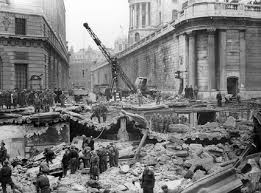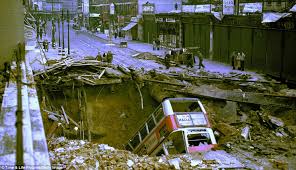In recent weeks I've been looking at London during and after the Blitz. For a decade or more years after the war the city was still scarred by the damage caused by Hitler's Luftwaffe. According to many accounts, you could wander around the city well into the 1950s and still see whole rows of houses missing, their cellars exposed to the sky, tall weeds growing over the rubble. Children were able to pick and eat gooseberries from the bushes that grew on bomb sites. The country was simply too impoverished by the war to be able to afford to start rebuilding.
I came across the video above, of rare colour footage of the effects of the bombing, which includes a few London landmarks as well as Winston Churchill surveying the damage.
A few other stories and images have stuck in my mind during my research, most of them linked to my fascination with the underground. In 1941 a German bomb struck a direct hit on the ticket hall of Bank underground station, killing 57 people.

It must have shaken the public's confidence. The underground's became bomb shelters, a safe haven from the raining bombs above ground. In 1944 the air raid sirens went off in Bethnal Green and the locals started making their way to the shelter in the tube station. All of a sudden there was vast bang, like the sound of an exploding bomb, which created a wave of panic. On the narrow stairs which led to the entrance into the station someone slipped. People poured down, falling over each other, stepping on others, the human instinct to survive trumping all other. 173 people lost their lives, many of them children. The incident was reported, though the severity and the location weren't mentioned to avoid denting morale. Neither was it reported, though it was later admitted, that the bang that created the panic was the testing of a new, secret anti-aircraft gun in a nearby park and not a German bomb.

In 1940, a bomb landed on Balham High Road above the tube station, creating a huge crater into which a bus crashed. The bomb fractured a water main which sent water, sewage and debris cascading down on to the platforms below. In all 68 people were drowned and killed. Those of you who have read or seen the film adapation of Ian McEwan's
Atonement will know the incident well.
During the Blitz, even well below ground, you weren't safe.
cheers
Dan - Friday


As the the film clip brings home, certain memories never fade away.
ReplyDeleteDan, there were still numerous bomb sites in South London, and Bristol, in the early 1960s. We hear so frequently about the bombing of Dresden and Hamburg that it is good for people to be reminded about the terrible damage Britain suffered.
ReplyDeleteGreat film piece. Little known fact: a long section of the FDR Drive (East River Drive) in NYC was built with rubble from bombed out buildings in Bristol, England. When American Liberty ships offloaded their supplies, they needed ballast for the return voyage. The Luftwaffe had unkindly provided a ready supply, which was then used in the construction of FDR Drive. So if you're ever in NYC and feel homesick, take a drive on the FDR.
ReplyDeleteFascinating Dan - in the 70's I remember areas of bombsites and as late as 2003ish near my friends place by Waterloo an fenced up bombsite where homeless camped
ReplyDeleteCara, Norm - I'm actually trying to find out the last remaining bombsite in London from WWll. I'll keep you posted.
ReplyDeleteAnd James, I'll remember that the next time I'm there and make sure I put on my best Bristolian accent.
I have always been amazed by the way in which the British were able to keep going through that period.
ReplyDeleteThere was only twenty years between the end of World War I and the beginning of World War II and the Depression began between the wars.
Could people in any western country today deal as well?
Thanks for that clip - I'm in the early stages of planning a historical mystery to take place during this time so I'm getting my grubby paws on all the information I can!
ReplyDeleteThis comment has been removed by the author.
ReplyDeleteI'm writing about this too, and what I can't find is the name of the bus driver and how many passengers were on the bus that drove into the crater in the dark. Everyone mentions the bus but for all I can tell, the empty bus drove itself! any help?
ReplyDelete